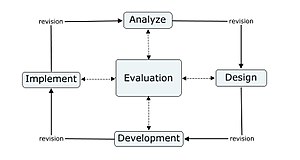An instructional theory is "a theory that offers explicit guidance on how to better help people learn and develop." It provides insights about what is likely to happen and why with respect to different kinds of teaching and learning activities while helping indicate approaches for their evaluation. Instructional designers focus on how to best structure material and instructional behavior to facilitate learning.
Instructional design (ID), also known as instructional systems design and originally known as instructional systems development (ISD), is the practice of systematically designing, developing and delivering instructional materials and experiences, both digital and physical, in a consistent and reliable fashion toward an efficient, effective, appealing, engaging and inspiring acquisition of knowledge. The process consists broadly of determining the state and needs of the learner, defining the end goal of instruction, and creating some "intervention" to assist in the transition. The outcome of this instruction may be directly observable and scientifically measured or completely hidden and assumed. There are many instructional design models, but many are based on the ADDIE model with the five phases: analysis, design, development, implementation, and evaluation.
A learning management system (LMS) or virtual learning environment (VLE) is a software application for the administration, documentation, tracking, reporting, automation, and delivery of educational courses, training programs, materials or learning and development programs. The learning management system concept emerged directly from e-Learning. Learning management systems make up the largest segment of the learning system market. The first introduction of the LMS was in the late 1990s. LMSs have been adopted by almost all higher education institutions in the English-speaking world. Learning management systems have faced a massive growth in usage due to the emphasis on remote learning during the COVID-19 pandemic.
Transactional distance theory was developed in the 1970s by Dr. Michael G. Moore, Distinguished Professor Emeritus of Education at the Pennsylvania State University. It is the first pedagogical theory specifically derived from analysis of teaching and learning conducted through technology as opposed to the many theories developed in the classroom. It is considered by some to be one of the few, if not the only, theory in distance education that can be used to test hypotheses. It can be used to frame experiments in tutoring or other learner support activities to assess what change there is in the outcomes of student learning, often judged by student completion. Like any theory, the transactional distance model serves as a heuristic device, a means of identifying questions for research and also a very practical instrument to be used in making these difficult instructional design decisions.
Universal Design for Learning (UDL) is an educational framework based on research in the learning theory, including cognitive neuroscience, that guides the development of flexible learning environments and learning spaces that can accommodate individual learning differences.
Mastery learning is an instructional strategy and educational philosophy, first formally proposed by Benjamin Bloom in 1968. Mastery learning maintains that students must achieve a level of mastery in prerequisite knowledge before moving forward to learn subsequent information. If a student does not achieve mastery on the test, they are given additional support in learning and reviewing the information and then tested again. This cycle continues until the learner accomplishes mastery, and they may then move on to the next stage. In a self-paced online learning environment, students study the material and take assessments. If they make mistakes, the system provides insightful explanations and directs them to revisit the relevant sections. They then answer different questions on the same material, and this cycle repeats until they reach the established mastery threshold. Only then can they move on to subsequent learning modules, assessments, or certifications.
An intelligent tutoring system (ITS) is a computer system that imitates human tutors and aims to provide immediate and customized instruction or feedback to learners, usually without requiring intervention from a human teacher. ITSs have the common goal of enabling learning in a meaningful and effective manner by using a variety of computing technologies. There are many examples of ITSs being used in both formal education and professional settings in which they have demonstrated their capabilities and limitations. There is a close relationship between intelligent tutoring, cognitive learning theories and design; and there is ongoing research to improve the effectiveness of ITS. An ITS typically aims to replicate the demonstrated benefits of one-to-one, personalized tutoring, in contexts where students would otherwise have access to one-to-many instruction from a single teacher, or no teacher at all. ITSs are often designed with the goal of providing access to high quality education to each and every student.
Computer-supported collaborative learning (CSCL) is a pedagogical approach wherein learning takes place via social interaction using a computer or through the Internet. This kind of learning is characterized by the sharing and construction of knowledge among participants using technology as their primary means of communication or as a common resource. CSCL can be implemented in online and classroom learning environments and can take place synchronously or asynchronously.
Human performance technology (HPT), also known as human performance improvement (HPI), or human performance assessment (HPA), is a field of study related to process improvement methodologies such as organization development, motivation, instructional technology, human factors, learning, performance support systems, knowledge management, and training. It is focused on improving performance at the societal, organizational, process, and individual performer levels.

Backward design is a method of designing an educational curriculum by setting goals before choosing instructional methods and forms of assessment. Backward design of curriculum typically involves three stages:
- Identify the results desired
- Determine acceptable levels of evidence that support that the desired results have occurred
- Design activities that will make desired results happen
Training and development involve improving the effectiveness of organizations and the individuals and teams within them. Training may be viewed as related to immediate changes in organizational effectiveness via organized instruction, while development is related to the progress of longer-term organizational and employee goals. While training and development technically have differing definitions, the two are oftentimes used interchangeably and/or together. Training and development have historically been topics within adult education and applied psychology but have within the last two decades become closely associated with human resources management, talent management, human resources development, instructional design, human factors, and knowledge management.
An instructional simulation, also called an educational simulation, is a simulation of some type of reality but which also includes instructional elements that help a learner explore, navigate or obtain more information about that system or environment that cannot generally be acquired from mere experimentation. Instructional simulations are typically goal oriented and focus learners on specific facts, concepts, or applications of the system or environment. Today, most universities make lifelong learning possible by offering a virtual learning environment (VLE). Not only can users access learning at different times in their lives, but they can also immerse themselves in learning without physically moving to a learning facility, or interact face to face with an instructor in real time. Such VLEs vary widely in interactivity and scope. For example, there are virtual classes, virtual labs, virtual programs, virtual library, virtual training, etc. Researchers have classified VLE in 4 types:
Adaptive learning, also known as adaptive teaching, is an educational method which uses computer algorithms as well as artificial intelligence to orchestrate the interaction with the learner and deliver customized resources and learning activities to address the unique needs of each learner. In professional learning contexts, individuals may "test out" of some training to ensure they engage with novel instruction. Computers adapt the presentation of educational material according to students' learning needs, as indicated by their responses to questions, tasks and experiences. The technology encompasses aspects derived from various fields of study including computer science, AI, psychometrics, education, psychology, and brain science.
Educational data mining (EDM) is a research field concerned with the application of data mining, machine learning and statistics to information generated from educational settings. At a high level, the field seeks to develop and improve methods for exploring this data, which often has multiple levels of meaningful hierarchy, in order to discover new insights about how people learn in the context of such settings. In doing so, EDM has contributed to theories of learning investigated by researchers in educational psychology and the learning sciences. The field is closely tied to that of learning analytics, and the two have been compared and contrasted.
Jerrold Kemp was a researcher in the field of Instructional Design. He was the main contributor to the Kemp Instructional Design Model.
Design-based learning (DBL), also known as design-based instruction, is an inquiry-based form of learning, or pedagogy, that is based on integration of design thinking and the design process into the classroom at the K-12 and post-secondary levels. Design-based learning environments can be found across many disciplines, including those traditionally associated with design, as well as others not normally considered to be design-related. DBL, as well as project-based learning and problem-based learning, is used to teach 21st century skills such as communication and collaboration and foster deeper learning.
Information Communications Technology is usually included in the Home Economics and Livelihood Education program in grade school and taught through the Technology and Home Economics program in high school. The recent status of ICT education in the Philippines, along with other Southeast Asian countries, was surveyed by the Southeast Asian Ministers of Education Organization (SEAMEO) in 2011. Using the UNESCO model of ICT Development in Education, the countries were ranked as Emerging, Applying, Infusing or Transforming. The Philippines were ranked at the Infusing stage of integrating ICT in education, indicating that the country has integrated ICT into existing teaching, learning and administrative practices and policies. This includes components such as a national vision of ICT in education, national ICT plans and policies, complementary national ICT and education policies, professional development for teachers and school leaders, community or partnership and teaching and learning pedagogies. A 2012 study reported that public high schools in Metro Manila had a computer to student ratio of 1:63. While 88 percent of schools have internet connections, half of the students claimed not to be using it.
The Knirk & Gustafson Instructional Design Model is an instructional model that was developed by Frederick G. Knirk and Kent L. Gustafson in 1986. Their model has three stages:
Robert Heinich was an American instructional designer, instructional technologist, author, and editor.


